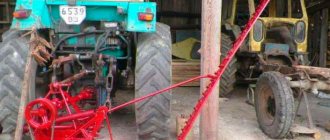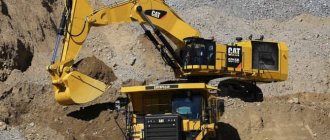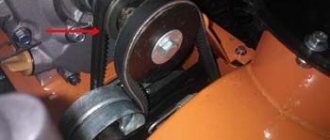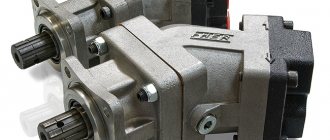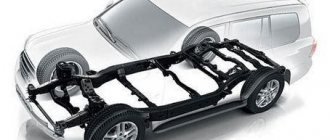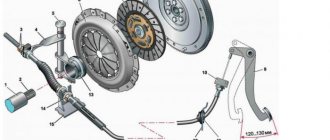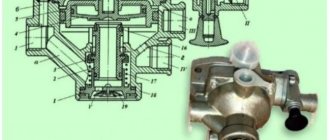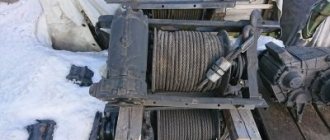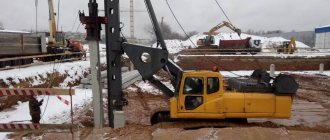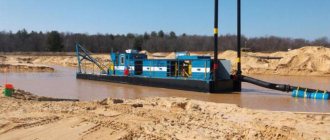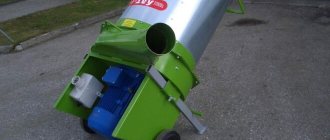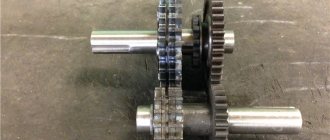The lifting capacity of a forklift is an intuitive thing for everyone. If you need to lift a load weighing 1100 kg, then naturally you need a forklift of equal or greater lifting capacity. For forklifts, this is a loader with a lifting capacity of 1.5 tons, the so-called “one and a half ton”, the most common in Russia. But what mast (forklift, boom) to choose for a loader so that it meets your needs in terms of lifting height, you need to be savvy in this matter and not miss the choice, otherwise you simply will not be able to use your fork purchase.
Types of Forklift Lifts
Loader masts are:
- Duplex standard is a two-section mast with standard free movement.
- Duplex free lift is a two-section mast with a special free lift.
- Triplex - three-section mast.
- Quadroplex is a four-section mast (not discussed in detail in this article).
Different loader manufacturers designate mast types differently in their specifications, but this does not change the essence. In our opinion, the mast markings are best implemented on Japanese Nissan loaders: 2W, 2F, 3F. Where the number indicates the number of sections and the letter F indicates the presence of a special free wheeling of the forklift. It is also customary to designate these masts with the letters FV, FFV, TFV.
Duplex mast with standard free movement
This type of mast has two sections and two lifting cylinders located on the sides.
With such a mast, the forks rise to a height of 150 mm from the ground, and then the inner section of the mast begins to extend, thereby increasing the height of the loader. The lifting heights of such masts range from 3.0 m to 5.0 m. The standard lifting height for loaders is considered to be 3.0 m, because when folded the mast is 2,000 mm high from the floor, which is lower or equal to the height of the loader itself and makes it Anything less makes no sense. Maximum 5.0 m - because when folded the mast is already 3100 mm high and difficult to pass through the warehouse gates. Official dealers of forklift manufacturers import and keep in stock forklifts with standard 3.0 m masts, since there is a high demand for them. The cost of forklifts with such masts is lower than with special lifts. The kinematic diagram of a standard duplex mast is as follows.
When you press the lift lever on the loader, the hydraulic cylinders begin to move up and lift the inner section of the mast on which the blocks (pulley system) with chains attached to the carriage are located. Thanks to this, the cargo carriage with forks also begins to rise up. From the course of theoretical mechanics it is known that the block moves at a speed 2 times slower than the load we want to lift. In this way, you can calculate the height of the mast in the raised position at the desired height of the forks.
Tires
It may seem strange at first glance, but the maneuverability and speed of a forklift largely depend on its components such as tires. Until the late 1930s, forklift wheels were typically equipped with band tires. A ring made of dense and wear-resistant rubber was first glued onto a steel ring, and then pressed together with it onto the cylindrical rim of the wheel. The main problem, which was solved for some time, was the development of technology that would prevent such a tire from slipping off a flat cylindrical rim: for this, the shape of the rim and the edge of the tire had to exactly match each other. Later, pneumatic tires and massive superelastic tires began to be used. To ensure that forklifts do not leave marks on the floor when braking and turning, which is necessary when working in food and pharmaceutical plants, they are equipped with so-called “non-marking” tires.
There are large differences in tire application between the US market and other markets. In the United States, forklifts are predominantly equipped with tires, while in other regions of the world they use mainly pneumatic or solid tires. Bandage tires provide the most reliable grip when working on smooth floors or road surfaces. Forklifts equipped with them, while having the same load capacity and stability as models with pneumatic or solid tires, are more compact, but, unfortunately, less comfortable for the driver. In 1936, Hyster released the first models of heavy-duty forklifts with pneumatic tires (Jumbo 7T). Currently, forklifts with pneumatic or solid tires successfully perform their functions on rough road surfaces, but in this case, of course, the quality of the tires, their pressure and the characteristics of the driving route play an important role.
Duplex mast with special free movement
The mast consists of two sections, like the standard one, but another special freewheel cylinder is added to the hydraulic circuit, which is located in the middle of the mast.
Its function is to raise the carriage with forks without changing the construction height of the forklift, and only then the inner section of the mast is extended using two side lifting cylinders. The most common lifting heights for these lifts vary from 3.0 m to 3.3 m. For a duplex “free lift” mast with a lifting height of 3.0 m, the free play of the forks with the load guard grid on the load carriage is 1100 mm instead of 150 mm the standard mast has a duplex, and without it - 1450 mm. Specialists in lifting equipment know this very well and always take this into account when purchasing a forklift.
This function is simply necessary if you need to take cargo from the second tier of a stack or racks, and it is not possible to raise the forks to such a height since the raised mast already rests against the ceiling. The most common case of using a “free lift” mast is the operation of a forklift in a railway car when unloading and loading it, when it is necessary not only to enter the car with an opening of 2300 mm, but also to raise the forks to a height of more than one meter in order to take the upper tier of pallets . That is why such a mast is called a “car-type mast” or “car-type mast.” The kinematic diagram of this forklift is as follows.
First, the central cylinder with the block and the forks rise with it. Then the main lift cylinders begin to operate and extend the inner section of the mast.
Please note that this lift is called the “wagon version” and not the “truck version”. Everything is simple and obvious. In a Eurotruck, pallets are rarely loaded onto pallets, since a Eurotruck has a carrying capacity of 20 tons, and the area can accommodate only 33 pallets with cargo (pallets). It turns out that if the cargo is stacked on top of each other and weighs 1000 kg, then the truck should fit 66 such pallets and the weight will be 66 tons, but the load capacity of the truck is 20 tons. Conversely, if the load is light, then it is usually made high so that it is convenient to handle and fewer operations are required when loading and unloading. But a railway car has a carrying capacity of 68 tons and it is possible to load pallets on top of each other, since its carrying capacity allows it.
Bulgarian miracle duplex mast
Balkankar engineers decided to revolutionize the world's principles of forklift manufacturing and manufactured a duplex mast with free-running forks using only one telescopic central lifting cylinder.
Attachments
One of the most common working parts for loaders is the lateral displacement mechanism of the forks, which facilitates the positioning of cargo on a rack or in the body of a vehicle. The first mechanisms for lateral displacement of the forks appeared around the Second World War and were mounted in front on the crossbeam of the supporting fork. This reduced the carrying capacity by about 10%. Nowadays, the sideshift mechanism is usually built into the carriage, so that there is almost no loss of lifting capacity. The permissible amount of lateral displacement is regulated by European Union standards: for example, for forklifts with a maximum load capacity of less than 5 tons, it can be a maximum of 100 mm in both directions - under this condition, the residual load capacity is not reduced. Integrated side shift and other advanced attachments provide greater residual lift capacity as their overhang and weight are continually reduced. The new sideshift mechanisms have a box-shaped profile: this design provides a better view of the fork ends and the load and thus greater safety for the driver.
Triplex mast
Unlike its predecessors, the mast already has three sections. For forklifts and electric forklifts, these masts always have a special freewheel by default.
The advantage of such booms is not only that they have free movement of the forks like a duplex mast with free movement, but also that their construction height allows you to enter a wagon or Eurotruck and at the same time load pallets to a height above 4, 5 m, up to 5.5 m. The range of such lifts ranges from 3.3 m to 7.0 m for loaders and up to 13.5 m for reach trucks. Such lifts increase the capacity of your warehouse compared to conventional masts by 30% or even 50%, since it becomes possible to lift the load higher one or two tiers on the racks.
According to the kinematic scheme, the triplex mast combines the first two masts.
First, the freewheel cylinder works, then the main lifting cylinders, which lift the second section of the mast, and through a system of blocks it pulls up the third section of the mast with the carriage and forks. This mast is more versatile and that is why forklift suppliers try to stock equipment with these forklifts.
Note:
Self-propelled electric stackers use triplex masts in three folds, both without freewheeling and with it. Check with dealers when purchasing.
A special case of a triplex mast with two cylinders for free lifting of the forks. Such masts are mainly used on heavy-duty loaders from 11.0 to 45.0 tons, since there is more distance between the mast sections and it is possible to install not one but two freewheel cylinders so that the operator can better see the load when processing it.
Internal combustion engine
Gasoline and diesel engines have undergone significant changes not only in appearance. In the process of technical improvement, they became more and more powerful, economical, environmentally friendly and less noisy. From their introduction until about 1960, most forklifts were equipped with engines derived from automobiles.
This continued until Toyota was the first, according to its own statement, to create extremely economical industrial engines with lower rotation speeds. The first diesel engines for loaders were six-cylinder with a displacement of 4000 m3, later they were replaced by three- or four-cylinder engines with a displacement of 2000 cm3 or less, but their power was the same. Air-cooled engines were followed by water-cooled engines, which can be better insulated and thus produce lower sound pressure. Subsequently, all over the world they began to attach increasing importance to safety and comfort when working with equipment. The emissions of internal combustion engines, as well as the level of noise they create, began to be regulated by strict regulations. In Europe, diesel drives were increasingly being replaced by gasoline drives.
Finally, the German company Still has created very economical hybrid diesel-electric units instead of smoking diesel. Equipment with internal combustion engines is losing its position in the market not only due to stricter environmental protection standards, but also due to the intensive development and growth in sales of in-warehouse floor transport, which is powered exclusively by electricity.
Nevertheless, diesel engines still continue to be used on loaders that are produced for the European market, and there are several reasons for this. Firstly, due to cost, since a diesel power unit requires less investment in purchase, energy consumption and maintenance than an electric one. Secondly, diesel is still a reliable, easy to maintain, powerful and efficient source of energy. Of course, its big drawback is the emission of soot, which increases even more with changes in engine speed and the use of sulfur-containing (straight-run) diesel fuel. To some extent, this problem is solved by a particulate filter: depending on the quality and type, it reduces harmful emissions by 70...98%, but even today at most 4 to 5% of all diesel engines are equipped with such filters, primarily due to their very high sales price – from 2 to 4 thousand euros.
Along with diesel engines, gaseous fuel engines are also used, which are most often suitably reconstructed gasoline engines. The buyer can choose between a hybrid unit or a unit running on pure gaseous fuel. In the case of a hybrid system, the driver can “switch” the car from gas to gasoline. This is advisable when it is not possible to directly fill the car with gas and the driver is focused on using spare cylinders. In this case, gasoline is used until a full cylinder is delivered from the warehouse (the time when the driver must connect a spare cylinder is indicated by an indicator lamp). However, the engine power when running on gasoline and gas fuel is not the same, so it is not used optimally, and the buyer in most cases chooses a gas engine. Pure petrol engines in forklifts are still rare in Europe: more than 95% of all petrol engines in forklifts have already been converted to use gaseous fuels.
Simplex single section mast
The simplex mast has only one section, so it does not have side lifting cylinders, but only a central cylinder, which is both a freewheel cylinder and a main lift cylinder. Explicit representatives and owners of such masts are hydraulic stackers with a lifting height of 1.6 m.
Electrical diagram
The electrical equipment of the loader has single-wire wiring, the operation of which is ensured by a constant voltage of 12 V. The electrical system of this type of equipment includes the following elements:
- battery,
- starter electric motor,
- alternator,
- battery charging relay,
- a relay that turns on the motion circuit,
- control and measuring equipment with sensors,
- alarm devices,
- lighting devices.
where: 1 - induction coil B1, 2 - spark plugs, 3 - suppressive resistance, 4 - rear light, 5 - battery 3 - batteries (2 pcs.) 6 - light switch, 7 - ignition switch, 8 - sound button signal, 9 - sound signal, 10 - light switch, 11 - fuel level sensor, 12 - fuse block, 13 - drive connector, 14 - headlight, 15 - water temperature sensor, 16 - oil temperature sensor, 17 - portable lamp, 18 - portable lamp socket, 19 - hog combinations, 2 - starter, 21 - distributor, 22 - relay regulator, 23 - generator.
The electrical wiring of the forklift includes wires of various sections (single or bundled), each of which is marked. The devices are connected to the positive pole of the battery, the negative pole is connected to ground to the chassis.
The ammeter allows you to determine the strength of the discharge and charging current when the generator and battery are operating simultaneously, as well as the strength of the discharge current when turning on current consumers with the engine off. Electrical faults can be determined using a special diagnostic tool.
Mast replacement
Practice shows that when buying a forklift, customers try to save money and buy forklifts and electric forklifts with a standard mast, since it is cheaper.
Then they move to another warehouse, where the racks are already one tier higher. So what should I do? Buy a new forklift? But the existing one is satisfactory, except for the lifting height. Change the mast? But who will help? "Sklad.ru" replaces the mast or replaces the loader in its own Service Center. Send a request or call 8-800-250-83-33
Brakes
As for the braking system, the driving comfort and safety of the machines were increased primarily due to the development of hydraulic structures. The first transport trolley of the Clark brand, model 1917, and some other examples of this equipment, produced in the 1920–1930s, did not yet have brakes. Only the next generation of floor transport equipment received mechanical brakes, but very soon they were replaced by hydraulic brake systems. Currently, almost every loader with a lifting capacity of over 2 tons has a hydraulic brake booster, which can turn even minimal pedal pressure into a vigorous braking process. To keep the cost of servicing these systems as low as possible, most South Korean firms such as Daewoo, Hyundai and Samsung (Clark) now equip their forklifts with oil-immersion disc brakes, which were standard equipment at other companies. for heavy loaders only. Until recently, this technology was considered too expensive, but experience shows that the many advantages of oil bath brakes far outweigh their high cost. Thanks to a smoother braking process, and above all an increase in braking force without wheel locking, the reliability of these units has significantly increased.
There are other developments as well. After the creation of the hydrostatic transmission, Linde also went its own way in the field of braking technology. Thanks to the hydrostatic power transmission, it is possible to operate well both functions - acceleration and braking (a side effect of the hydrostatic drive) - and control forward and backward movements with just one pedal.
When it comes to acceleration and changing direction, hydrostatically driven loaders are the most efficient. Caterpillar, Clark and finally Jungheinrich have tried to develop in this area, but so far their attempts have been unsuccessful. Driving a car with hydrostatic drive takes some practice, but anyone who has ever had the opportunity has experienced all the benefits that a conventional torque converter transmission lacks.
Part 1 Part 2
